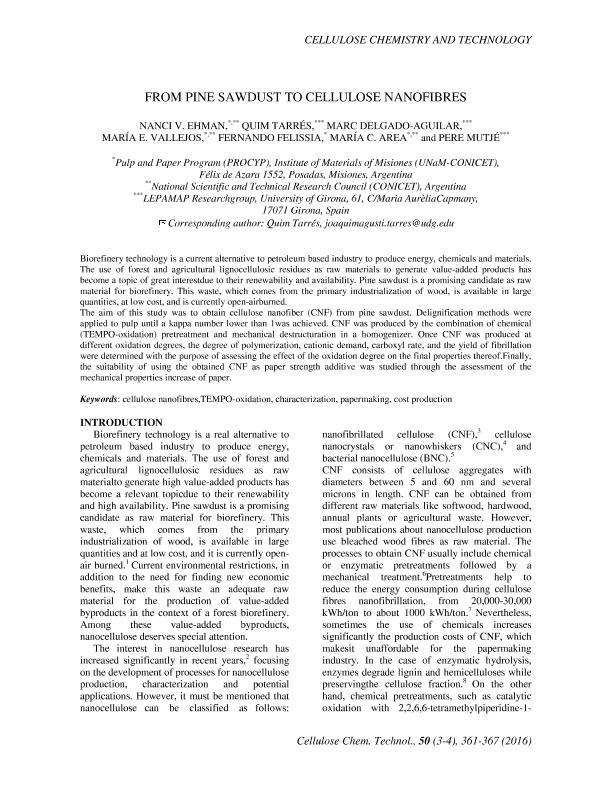Artículo
From pine sawdust to cellulose nanofibers
Ehman, Nanci Vanesa ; Tarrés, Quim; Delgado Aguilar, Marc; Vallejos, María Evangelina
; Tarrés, Quim; Delgado Aguilar, Marc; Vallejos, María Evangelina ; Felissia, Fernando Esteban; Area, Maria Cristina
; Felissia, Fernando Esteban; Area, Maria Cristina ; Mutjé, Puré
; Mutjé, Puré
 ; Tarrés, Quim; Delgado Aguilar, Marc; Vallejos, María Evangelina
; Tarrés, Quim; Delgado Aguilar, Marc; Vallejos, María Evangelina ; Felissia, Fernando Esteban; Area, Maria Cristina
; Felissia, Fernando Esteban; Area, Maria Cristina ; Mutjé, Puré
; Mutjé, Puré
Fecha de publicación:
03/2016
Editorial:
Editura Acad Romane
Revista:
Cellulose Chemistry And Technology
ISSN:
0576-9787
e-ISSN:
2457-9459
Idioma:
Inglés
Tipo de recurso:
Artículo publicado
Clasificación temática:
Resumen
Biorefinery technology is a current alternative to petroleum based industry to produce energy, chemicals and materials. The use of forest and agricultural lignocellulosic residues as raw materials to generate value-added products has become a topic of great interestdue to their renewability and availability. Pine sawdust is a promising candidate as raw material for biorefinery. This waste, which comes from the primary industrialization of wood, is available in large quantities, at low cost, and is currently open-airburned. The aim of this study was to obtain cellulose nanofiber (CNF) from pine sawdust. Delignification methods were applied to pulp until a kappa number lower than 1was achieved. CNF was produced by the combination of chemical (TEMPO-oxidation) pretreatment and mechanical destructuration in a homogenizer. Once CNF was produced at different oxidation degrees, the degree of polymerization, cationic demand, carboxyl rate, and the yield of fibrillation were determined with the purpose of assessing the effect of the oxidation degree on the final properties thereof.Finally, the suitability of using the obtained CNF as paper strength additive was studied through the assessment of the mechanical properties increase of paper.
Archivos asociados
Licencia
Identificadores
Colecciones
Articulos(IMAM)
Articulos de INST.DE MATERIALES DE MISIONES
Articulos de INST.DE MATERIALES DE MISIONES
Citación
Ehman, Nanci Vanesa; Tarrés, Quim; Delgado Aguilar, Marc; Vallejos, María Evangelina; Felissia, Fernando Esteban; et al.; From pine sawdust to cellulose nanofibers; Editura Acad Romane; Cellulose Chemistry And Technology; 50; 3; 3-2016; 361-367
Compartir



